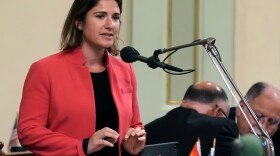The last primary night before the 2010 mid-term election was unquestionably a big night for the Tea Party movement.
But even as Tea Party supporters celebrated their victories, the question on many minds was whether the movement was experiencing its high water mark on Tuesday evening.
In the most watched race of the evening, Christine O'Donnell won big in Delaware, becoming the Republican nominee for senator. She defeated Rep. Mike Castle, one of the state's biggest political heavyweights. He had been expected to easily beat Democrat Chris Coons to win the seat for Republicans, getting them closer to gaining a Senate majority.
Further north up I-95 in New York, another Tea Party choice, businessman Carl Paladino, pasted former Congressman Rick Lazio to win the Republican governor's nomination.
The results on the Republican side continued the run of successes the Tea Party movement has had this year.
Tea Party victories in Massachusetts, Utah, Nevada, Florida, Alaska and now Delaware and New York were fueled by anger towards Washington over deficits, bailouts, the health care overhaul and the economy.
But Republican primaries have long been decided by the most conservative activist voters. For years, the pattern of candidates winning the GOP nomination has been to run to the right to win nominations, then head to the center for general elections. Their Democratic counterparts were forced by their liberal base to the center from the other end of the political spectrum.
The Tea Party appears to be just the latest manifestation of that long-term phenomenon.
The question for the newly minted nominees of the Tea Party and the Republican Party is whether they will have the ideological flexibility to move to the middle or even want to.
Democrats certainly hope the answer to that question is no since they are banking on the electorate's center of gravity remaining closer to the political middle than either end of the ideological spectrum.
And national Republicans have appeared cool to the some of the Tea Party candidates like O'Donnell and Sharron Angle in Nevada. An open question is how much money, if any, national Republicans will invest in races where Tea Party candidates run against more centrist Democrats.
Meanwhile, it definitely wasn't a bad night for all incumbents. Rep. Charles Rangel faced perhaps his toughest primary challenge in decades because of his ethics troubles.
But he was handily re-elected to represent his Harlem district, defeating Adam Clayton Powell IV, the name sake of the man Rangel beat to win the seat four decades ago.
Rangel's victory had some downside risks for Democrats since it meant they would still need to deal with charges that they have failed to clean up Congress as they promised they would in 2006.
But just as the Tea Party victories energized some Republican activists, they gave Democrats renewed hope that they would hang on to their Senate majority which had appeared more at risk before Tuesday evening.
Democrats argued that the majority of voters in Delaware and Nevada, for instance, wouldn't vote for Republican candidates that could easily be painted as too extreme than the more moderate Republicans they defeated.
The relative quietness of the Republican establishment suggested that they agreed as well that the Republican-Tea Party nominees would wind up being weak links in November.
Not long from now, we'll learn if all those doubts directed at the Tea Party were justified.
Copyright 2022 NPR. To see more, visit https://www.npr.org. 9(MDAzMjM2NDYzMDEyMzc1Njk5NjAxNzY3OQ001))







